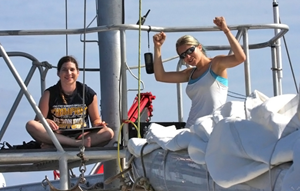
Kait Frasier (L) and Rachel Gottlieb (R) with Scripps Institution of Oceanography onboard the Ocean Alliance’s R/V Odyssey in the Gulf of Mexico celebrate after finding dolphins. (Photo provided by Frasier)
Kait Frasier listens to Gulf marine mammals to estimate how many there are and find out if their numbers are changing after the Deepwater Horizon oil spill. Kait sees dolphins as a good species to study because “everyone can see and understand them, not just scientists.”
Kait, a Ph.D. student at the Scripps Institution of Oceanography at the University of California – San Diego, is a GoMRI Scholar with C-IMAGE. She shares her journey, work, and hopes for the future.
Her Path
Kait’s journey into dolphin research came as a pleasant surprise. Despite initially wanting to study deep sea worms, she interned with Dr. John Hildebrand in the underwater bioacoustics lab, using sound to locate whales and dolphins. Being a Biology major, she felt “this was way over my head,” but needing a job, she stuck with it. She thought that working with dolphins would be “a touchy-feely sort of science.” However, Kait soon discovered that the science was surprisingly heavily rooted in physics, math, and computing; so, she took more classes and learned programming.
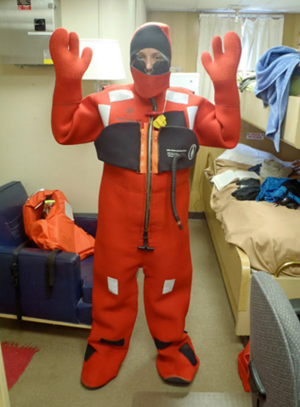
On NOAA’s R/V Gordon Gunter, in the Gulf of Mexico, Kait Frasier dons a survival suit (referred to as a “Gumby Suit”). Researchers have to be able to get into it in under a minute, which takes some practice. (Photo provided by Frasier)
As her role evolved, Kait entered a Ph.D. program in marine mammal bioacoustics, something she “hadn’t even known was ‘a thing’ up until that point” and that “people only do in their dreams.” Not so bad. With this new focus, Kait said that “the combination of the insane beauty of the ocean and the challenges of the research” drew her into the field.
Her Work
As Kait completed her first year of grad school, the Deepwater Horizon oil spill happened. The “horrifying” images made her “not want to think about it.” However, her advisor urged her to focus her thesis on the Gulf of Mexico. So Kait soon found herself “afloat in the Gulf for months at a time,” using sounds to study dolphins “because we would really like to know how those populations are doing in the aftermath of the spill.”
“Dolphins make two main types of sounds,” explains Kait, “whistles are for communication, and echolocation clicks are very focused beams of sound that a dolphin generates in its forehead.” Depending on the time it takes to bounce off a target and return, those clicks can tell a dolphin the distance of its target and if it is a viable food source.
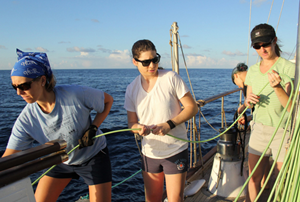
On the Ocean Alliance’s R/V Odyssey, a team of “super-tough women” help Kait Frasier (in background) deploy a hydrophone array. Using these underwater microphones, they listen for animal sounds and match them with the species that makes them. Doing this at sea allows them to find dolphins they hear and determine their type. (Photo provided by Frasier)
With about thirteen dolphin species in the Gulf, many living far offshore, it is expensive and time consuming to frequently deploy research vessels. So scientists record sounds with microphones that stay for extended periods on the ocean floor. Once they get the microphones back in the lab, the team decodes the sounds to get details about life down there. “Sound in the ocean is like light on land: It travels far and fast.”
What amazes Kait the most is releasing and recovering the microphones. The team deploys recording equipment in the middle of the Gulf in waters over a mile deep. A year later they return, send out a signal, and locate the instruments. “It’s always a minor miracle to me that this works,” says Kait.
Her Learning
While dolphins are “interesting, beautiful and intelligent in their own right,” Kait explains that this research is extremely important because within “the context of restoration and conservation, dolphins are indicators of ocean health.” She continues, “If dolphins are leaving historical habitats, declining in numbers, or sick, it’s a sign that there are much deeper problems in the marine environment that need attention.” One of her goals is to “help the field of acoustic marine mammal monitoring become more quantitative so that it can be used more widely, because I think it has a lot of potential.”
A different type of learning for Kait comes from being a C-IMAGE team member and part of the larger GoMRI science community. “In the research world, you always hear keynote speakers at big conferences saying vague things about collaboration and how more of it should happen. It’s easy to say, but not so easy to put into practice.” With C-IMAGE, she sees it happing. “Everyone involved works together towards a common goal” remarked Kait, and “is very kind and generous, constantly sharing information, ideas, and resources.”
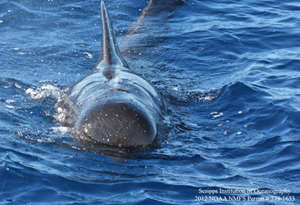
This image was captured by Amanda Debich on a 2012 C-IMAGE cruise. Kait describes this pilot whale (a dolphin) as looking like an “alien torpedo.” (Photo provided by Frasier)
For her, “it’s been a model for how interdisciplinary science can really work and why it matters.” Kait believes that restoring and making the Gulf a healthier place is possible because “the success of the C-IMAGE research group lies in that it really feels like a team – it’s exciting and inspiring.” She feels that her experiences have contributed to her growth and accomplishments saying, “I couldn’t do this without all of the people in the Scripps Whale Acoustic Lab. I’m a tiny part of a group of really brilliant, hardworking people who make this research happen.”
Her Future
At the moment, Kait is concentrating on completing her degree. This project has shown her that she wants to continue doing research that involves “tackling big questions with big data.”
Praise for Kait
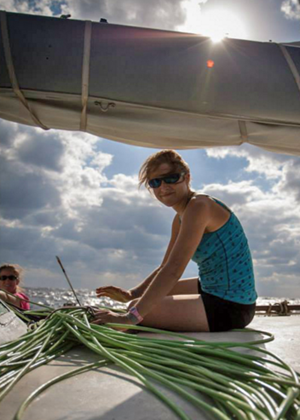
Kait Frasier secures gear on the Ocean Alliance’s R/V Odyssey last fall in the Gulf of Mexico. (Photo provided by Frasier)
Dr. John Hildebrand, her major professor, said that Kait has participated in NOAA-sponsored expeditions and has been the leader on several GoMRI-supported projects. He noted that while working on this project, “she has developed new approaches for estimating cetacean populations” and that he is “extremely pleased to be working with her.”
The GoMRI community embraces bright and dedicated students like Kait Frasier and their important contributions.
The GoMRI Scholars Program recognizes graduate students whose work focuses on GoMRI-funded projects and builds community for the next generation of ocean science professionals.
Visit the C-IMAGE web site to learn more about their work.
************
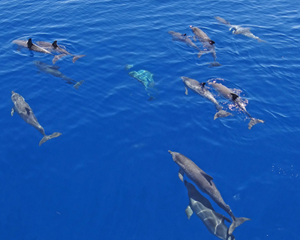
Pairs of tropical spotted dolphins in the Gulf of Mexico. (Picture by Steve Murawski)
This research was made possible in part by a grant from BP/The Gulf of Mexico Research Initiative (GoMRI) to the Center for Integrated Modeling and Analysis of Gulf Ecosystems (C-IMAGE). The GoMRI is a 10-year independent research program established to study the effect, and the potential associated impact, of hydrocarbon releases on the environment and public health, as well as to develop improved spill mitigation, oil detection, characterization and remediation technologies. An independent and academic 20-member Research Board makes the funding and research direction decisions to ensure the intellectual quality, effectiveness and academic independence of the GoMRI research. All research data, findings and publications will be made publicly available. The program was established through a $500 million financial commitment from BP. For more information, visit http://gulfresearchinitiative.org/.
